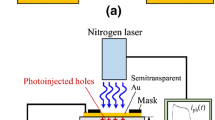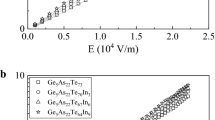Abstract
Amorphous selenium (a-Se) has an optical bandgap of ∼2.1 eV and a photogeneration efficiency close to unity at ∼2.7 eV which makes it sensitive to the blue region of the visible spectrum. Alloying with tellurium reduces the bandgap and hence increases the photosensitivity towards longer wavelengths. Experimental results have already been reported to show that charge acceptance, residual voltage, dark decay rate and drift mobility are all sensitive to tellurium. Charge acceptance and carrier drift mobilities decrease with tellurium whereas dark decay rate increases. All these effects are undesirable in xerography. Transient photoconductivity and residual voltage measurements were carried out to investigate the effect of a small chlorine addition on the xerographic properties of a-Se∶Te alloys. Results will be presented to show that chlorine improves the residual voltage and charge acceptance. Transient photoconductivity data on hole transport shows that the xerographically important parameter of carrier range is also improved. Hole drift mobility shows a weak field dependence of the form μ h ≃ E n where the index n is sensitive to chlorine. No electron transport could be detected in any of the samples. These results are interpreted in the framework of shallow-trap controlled transport.
Similar content being viewed by others
References
S. M. Vaezi-Nejad, PhD thesis, University of London, UK (1984).
R. M. Schaffert, (ed.), “Electrophotography principles and optimisation” (Research Studies Press, Letchworth, Herts, 1984) Ch. 4.
N. F. Mott and E. A. Davis (eds), “Electronic Processes in Non-Crystalline Materials”, 2nd Edn (Clarendon Press, Oxford, 1979) p. 530.
J. Mort and D. M. Pai (eds) “Photoconductivity and Related Phenomena” (Scientific Publishing Co., Amsterdam, 1976).
C. Juhasz, S. M. Vaezi-Nejad and S. Kasap, J. Mater. Sci. 22 (1987) 2569.
J. C. Schottmiller, J. Vac. Sci. Technol. 12 (1975) 807.
M. D. Tabak and W. J. Hillegas, ibid. 9 (1972) 387.
W. D. Spear, J. Non. Cryst. Solids 1 (1969) 197.
R. Wolf, “Advances in Materials and Device Research”, Vol. 3, Applied Solid State Science (Academic, New York, London, 1972).
K. Kiyota, A. Teshima and M. Tanaka, Photogr. Sci. Engng 24 (1980) 289.
S. M. Vaezi-Nejad, Int. J. Electron. 62(3) (1987) 361.
S. M. Vaezi-Nejad and C. Juhasz, to be published.
Idem, J. Semiconductor Sci. Technol. 2(1987) 809.
M. Abrowitz and J. M. Markovics, Solid State Commun. 44 (1982) 1431.
C. Juhasz, S. M. Vaezi-Nejad and S. O. Kasap, J. Img. Sci. 29(4) (1985) 144.
P. H. Keck, J. Opt. Soc. Amer. 41 (1951) 53.
Author information
Authors and Affiliations
Rights and permissions
About this article
Cite this article
Vaezi-Nejad, S.M., Juhasz, C. Effect of chlorine on xerographic properties of a-Se:Te alloys. J Mater Sci 23, 3286–3289 (1988). https://doi.org/10.1007/BF00551307
Received:
Accepted:
Issue Date:
DOI: https://doi.org/10.1007/BF00551307




